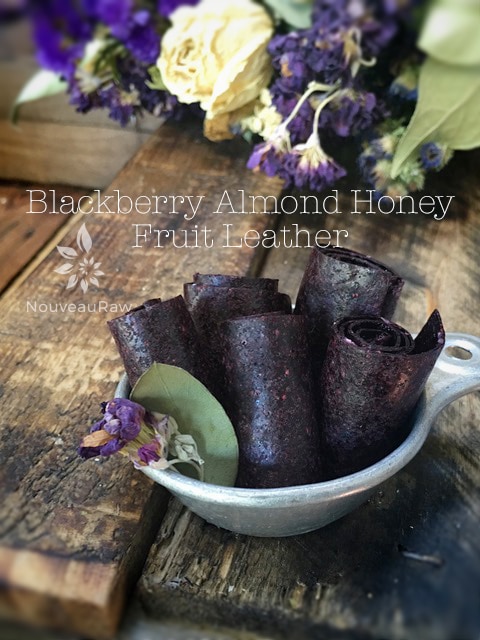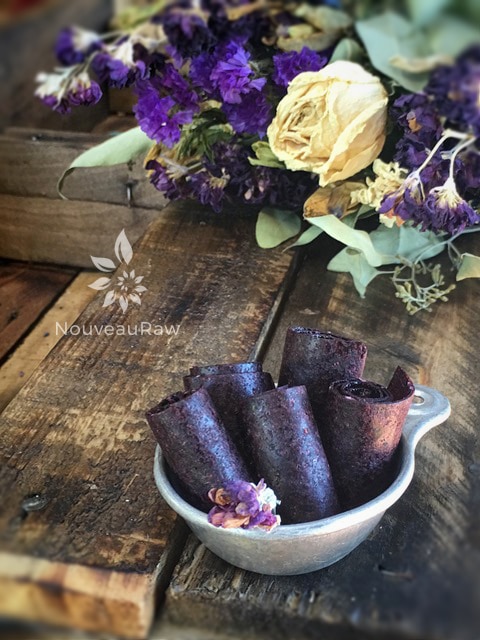Blackberry Almond Honey Fruit Leather

 Add to favorites
Add to favorites
 ~ raw, gluten-free ~
~ raw, gluten-free ~
I have blackberries coming out of my ears! It’s a little itchy, but I am loving it. I have a fruit fetish that is right up there with my shoe fetish. The thing about blackberries is that it is so amazing that something that tastes so good can be so good for you. Let’s look at just a few incredible health benefits they have…
Skin Health
As are all berries, blackberries are an excellent source of ellagic acid, an antioxidant shown to protect the skin from damage from ultraviolet light. Studies have also shown that ellagic acid may also repair skin damaged by the sun. Vitamin C helps heal wounds, and studies also show vitamin C may even lessen the appearance of wrinkles. Studies of cyanidin-3-glucoside, a compound found in blackberries showed it prevents skin cancer by inhibiting tumors from growing and spreading.
Eye Health
Vitamin C functions as an antioxidant in blackberries and one cup contains half of the daily recommendation of vitamin C. The body uses vitamin C for protection from immune system deficiencies and may reduce the chances of macular degeneration, a condition in which fine vision deteriorates, resulting in central vision loss and is the leading cause of blindness in people over 50.
Women’s Health
Phytoestrogens are naturally occurring plant estrogens found in blackberries that may help relieve the common symptoms of PMS like bloating, food cravings, and even menopausal symptoms including hot flashes.
Digestive Tract Health
Just one cup of blackberries contains over thirty percent of the daily recommended amount of fiber, which promotes healthy digestion and aids in maintaining bowel regularity by bulking up the feces and reducing the time it takes the matter to pass all the way through the intestines. Bowel regularity is commonly associated with a decreased risk of colon cancer. {source}
 Ingredients:
Ingredients:
yields 4 cup
- 5 cups fresh, organic blackberries
- 2 Tbsp chia seeds, ground in spice grinder
- 3 Tbsp raw honey
- 2 tsp Bee Pollen powder
- 1/2 tsp almond extract
- 1 dash Himalayan pink salt
- 1 cup raw almonds
Preparation:
- Select RIPE or slightly overripe blackberries that have reached a peak in color, texture, and flavor.
- Prepare the blackberries; wash and lightly pat dry. Wash only when ready to use.
- Puree the blackberries, chia, honey, bee pollen, almond extract, and salt in the blender or food processor until smooth.
- Taste and sweeten more if needed. Keep in mind that flavors will intensify as they dehydrate.
- When adding a sweetener do so 1 tbsp at a time, and reblend, tasting until it is at the desired taste.
- It is best to use a liquid type sweetener. Don’t use a granulated sugar because it tends to change the texture of the finished fruit leather.
- All the puree to rest for at least 10 minutes so the chia can do its thickening magic!
- Spread the fruit puree on teflex sheets that come with your dehydrator. Pour the puree to create an even depth of 1/8 to 1/4 inch. If you don’t have teflex sheets for the trays, you can line your trays with plastic wrap or parchment paper. Do not use wax paper or aluminum foil.
- Lightly coat the food dehydrator plastic sheets or wrap with a cooking spray, I use coconut oil that comes in a spray.
- When spreading the puree on the liner, allow about an inch of space between the mixture and the outside edge. The fruit leather mixture will spread out as it dries, so it needs a little room to allow for this expansion.
- Be sure to spread the puree evenly on your drying tray. When spreading the puree mixture, try tilting and shaking the tray to help it distribute more evenly. Also, it is a good idea to rotate your trays throughout the drying period. This will help assure that the leathers dry evenly.
- Dehydrate the fruit leather at 145 degrees (F) for 1 hour, then reduce temp to 115 degrees (F) for about 16 (+/-) hours. Flip the leather over about halfway through, remove the teflex sheet and continue drying on the mesh sheet. Finished consistency should be pliable and easy to roll.
- Check for dark spots on top of the fruit leather. If dark spots can be seen it is a sign that the fruit leather is not completely dry.
- Press down on the fruit leather with a finger. If no indentation is visible or if the fruit leather is no longer tacky to the touch, the fruit leather is dry and can be removed from the dehydrator.
- Peel the leather from the dehydrator trays or parchment paper. If the fruit leather peels away easily and holds its shape after peeling, it is dry. If the fruit leather is still sticking or loses its shape after peeling, it needs further drying.
- Under-dried fruit leather will not keep; it will mold. Over-dried fruit leather will become hard and crack, although it will still be edible and will keep for a long time
- Storage: to store the finished fruit leather…
- Allow the leather to cool before wrapping up to avoid moisture from forming, thus giving it a breeding ground for molds.
- Roll them up and wrap tightly with plastic wrap. Click (here) to see photos on how I wrap them.
- Place in an air-tight container, and store in a dry, dark place. (Light will cause the fruit leather to discolor.)
- The fruit leather will keep at room temperature for one month, or in a freezer for up to one year.
Culinary Explanations:
- Why do I start the dehydrator at 145 degrees (F)? Click (here) to learn the reason behind this.
- When working with fresh ingredients, it is important to taste test as you build a recipe. Learn why (here).
- Don’t own a dehydrator? Learn how to use your oven (here). I do however truly believe that it is a worthwhile investment. Click (here) to learn what I use.
Disclaimer
This website is not intended to provide medical advice. All content, including text, graphics, images, and information available on this site is for general informational, entertainment, and educational purposes only. The content is not intended to be a substitute for professional diagnosis or treatment. The author of this site is not responsible for any adverse effects that may occur from the application of the information on this site. You are encouraged to make your own health care decisions, based on your research and in partnership with a qualified healthcare professional.
© AmieSue.com
Tags: Dairy Free, Refined Sugar Free, Soy Free, sugar free



 Add to favorites
Add to favorites
 ~ raw, gluten-free ~
~ raw, gluten-free ~ Ingredients:
Ingredients:
How in the world do you grow blackberries in Tucson?? I can’t even grow lettuce in Miami AZ… I must have a black thumb! I envy your home-grown fruit!
Hi Brittany… all the fruit that we grow is in Oregon, where we now reside permanently. We use to go back and forth between AZ and OR but as of last month, we are staying close to home in OR. :) I agree, I can’t imagine anyone growing blackberries in AZ. hehe Have a wonderful evening, amie sue